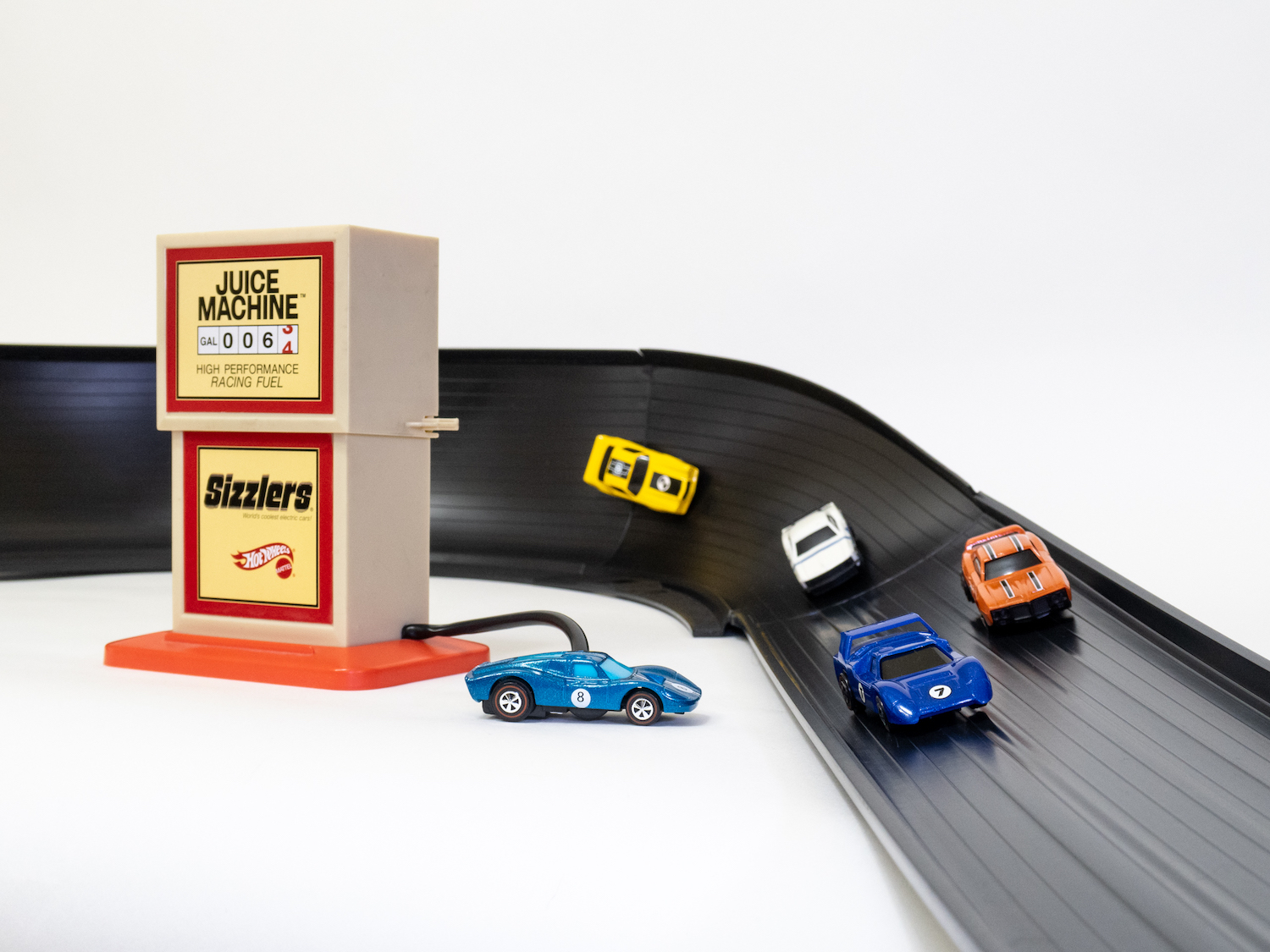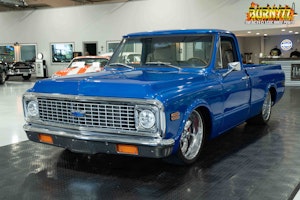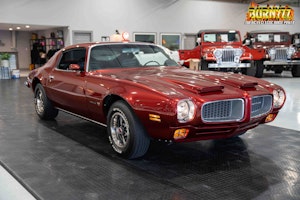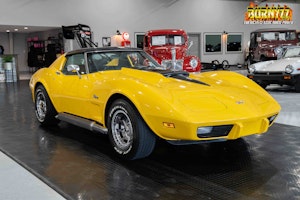Media | Articles
5 timelessly classic automotive Christmas toys
As long as there have been car toys, they’ve been a staple in Santa’s bag of tricks. We looked back to find some of our favorites. No matter your age, you can probably remember gifting or receiving one of these classics during a Christmas past.
Sizzlers

The ’70s brought six new Hot Wheels from Mattel that ripped around the orange track under their own power. Sizzlers packed a miniaturized electric motor powered by the first commercially available rechargeable nickel-cadmium battery, co-developed by Mattel and General Electric.
Four standard D-size batteries in a gas pump-styled Juice Machine and a 90-second charge was all it took to power the Sizzlers around the track for up to five minutes.
Legend has it that early Sizzler prototypes used exotic fuel combustion engines, but the plan was scuppered because kids already got enough vapors sniffing model glue. A dozen new Sizzlers arrived in ’71, and Mattel introduced the Fat Track with extra width straights and steeply banked corners for four-wide passing action. Kids learned about time dilation as their internal clocks conveyed the longest 90 seconds of all time and experienced real life range anxiety decades before full-size battery electric luxury SUVs.
Marketplace
Buy and sell classics with confidence
Sizzlers were discontinued in 1978 and slumbered until 2006 when Mattel reissued the Fat Track, cars, and accessories until it all disappeared again in 2009.
Go-Karts

As gravity-induced Pinewood and Soapbox Derby racing gave way to Big Wheels and their unique brand of entirely out of control downhill racing competition, kids around the country looked to motorized go-karts for their next-level driving experience. Go-karts ranged from kitted-out competition-ready performers to Monkey Wards or Sears catalog specials, like the well-sorted Orange Krate. Lesser versions featured spindly steel tube chassis, questionable brakes, and lawnmower engine power complete with grabby centrifugal clutch.
Even so, the worst catalog kart was like an Indy 500 car compared to Soapbox racers cobbled together with scrap wood and baby carriage wheels. All of them were orders of magnitude safer than Big Wheels. Go-karts with bodies made to mimic their full-size counterparts ranged from tiny Ferraris handcrafted in Maranello for the sons and daughters of mason jar barons to fiberglass facsimiles of Corvettes and Saab 900 Turbo convertibles for the rest of us.
Visible V-8

The Visible V-8 model made its debut in 1958, and countless kids soon built the shrunken internal combustion engine on the kitchen or dining room table. The 1/4-scale model kit included a crankshaft, rods, pistons, camshaft, pushrods, rockers, and simulated spark plugs that lit up at top dead center in the clear plastic engine block. Original Renwal kits featured an electric motor inside the starter that powered the rotating assembly. The Visible V-8 spawned similar simulated Renwal models like the Visible Automobile Chassis with a working transmission and differential so kids could drop in the Visible V-8. A visible engine hoist was not included.
Renwal branched out with the Visible Radial Airplane Engine, and other model manufacturers tooled up their own visible versions of everything from Wankel rotary engines to Honda CB750 inline-fours. Revell picked up the Visible V-8 in the mid-’70s and still sells a hand-cranked version of the classic model. The working 1/4-scale American mashup amalgam is one of the most popular models of all time and less disturbing to kids that watched one too many Creature Double Features than the invisible-skinned Visible Man.
COX-Powered RC Cars

The COX company sold countless .049-powered cars like the Baja Bug and Dune Buggy. Some had set-it-and-forget-it steering and ran in circles at best. Others drove on a wire type deal that guided the car in a straight line. Radio control finally made it into the mix in the early ’70s with ready to run kits like this Jerobee McLaren MK8B Cox-powered racer.
Starting the miniaturized engines was akin to warming up the single-cylinder Auto Union. Hook up a giant dry cell battery to the glow plug, fill the tank with nitromethane fuel, pull on the lawnmower-style cable, and the engine usually started. The next step was to dial in the mixture, close the hinged body just like Jungle Jim’s Funny Car, and let it rip. The RC kits were relatively affordable compared to far more sophisticated machines like the late-’70s Tamiya Sand Scorcher and cars could race each other as long as the other kid had a different frequency. Classic and modern RC cars run a methanol, castor oil, and nitromethane blend that is remarkably similar to the explosive brew that powers Top Fuel dragsters and Funny Cars to four-second ETs at 300-plus mph.
Total Control Racing
As nitro-powered RC cars and go-karts put a dent in slot car racing, Ideal came up with a Total Control Racing with electric cars that raced on slotless track. Kids around the country stared in disbelief as HO-scale cars steered and passed each other on TV commercials shown in between drag racing and demolition derby on Wide World of Sports.
TCR sets included the greatest tabletop racing innovation of all time. The autonomous Jam Car moped around the track and randomly blocked racing action. Top of the line sets came with two Jam Cars. High expectations of steerable slotless racing were crushed as TCR turned out to be a misnomer. Passing was indeed possible, but total control was a bit of a stretch. Cars hugged the wall on corner sections, and the epic slow motion drafting passes shown in the commercial were difficult to duplicate outside of TV land. TCR reappeared in the ’90s with superspeedway-style banked corners that made straightaway passing easier, but the technology was not enough against increasingly sophisticated RC cars and video games. (TCR sets and cars are collectible today and are not to be confused with the TCR touring racing series.)











I built the Visible V8 as a kid. It was fun.
My son built the visible V8 about 9 years ago when he was a kid. Although the plugs never worked quite right for some reason, the crank turned and the pistons went up and down, etc. I thought it was ‘cute’. Now he is a service tech for Mercedes Benz. Was that model the start of his career?
I had the Visible V8 with 3-speed trany and working frame. Push the clutch in and shift gears and watch it run. What a training tool that was for me.
Playmobil – Looked like a ’59 Ford dash and windshield. Man that was fun!
I remember the dashboard and windshield, but I was pretty young. I was a little old for sizzlers, but they were great. Nothing special on the track, but we had a slick garage floor that made for wild drifting action when wet with a sizzler.
The cox cars and planes were always hard to start, with frozen fingers getting whapped with the prop, or stung by a sticking pull cord. But when they started, the excitement was at a fever pitch that no other toy could match.
I love the Visible V8. Always thought it was cool.
I had a Visible V-8 that I built when I was about 10. A very educational toy.
A few years later I got a 1956 Mercedes GP car model powered by a Cox .049 engine. Put a nail in the floor of the porch, run a line to the car, start the engine by turning the rear wheel, and it would run in circles until it ran out of fuel. Lots of noise and smoke!
I built a Visible V8 when i was 13 that was battery powered by the starter. Took forever to build and when it was done i thought that it turned too slow on the supplied battery. So i took it out to the garage and hooked it up to my dads car battery. Man, it spun fast for about two revolutions and then disintegrated! Only engine i ever blew up and it was spectacular. Guess it taught me something after all. Would like to build another and maybe NOT blow it all over the garage.
They also made a visible slant six model. If you find one it probably still runs good.